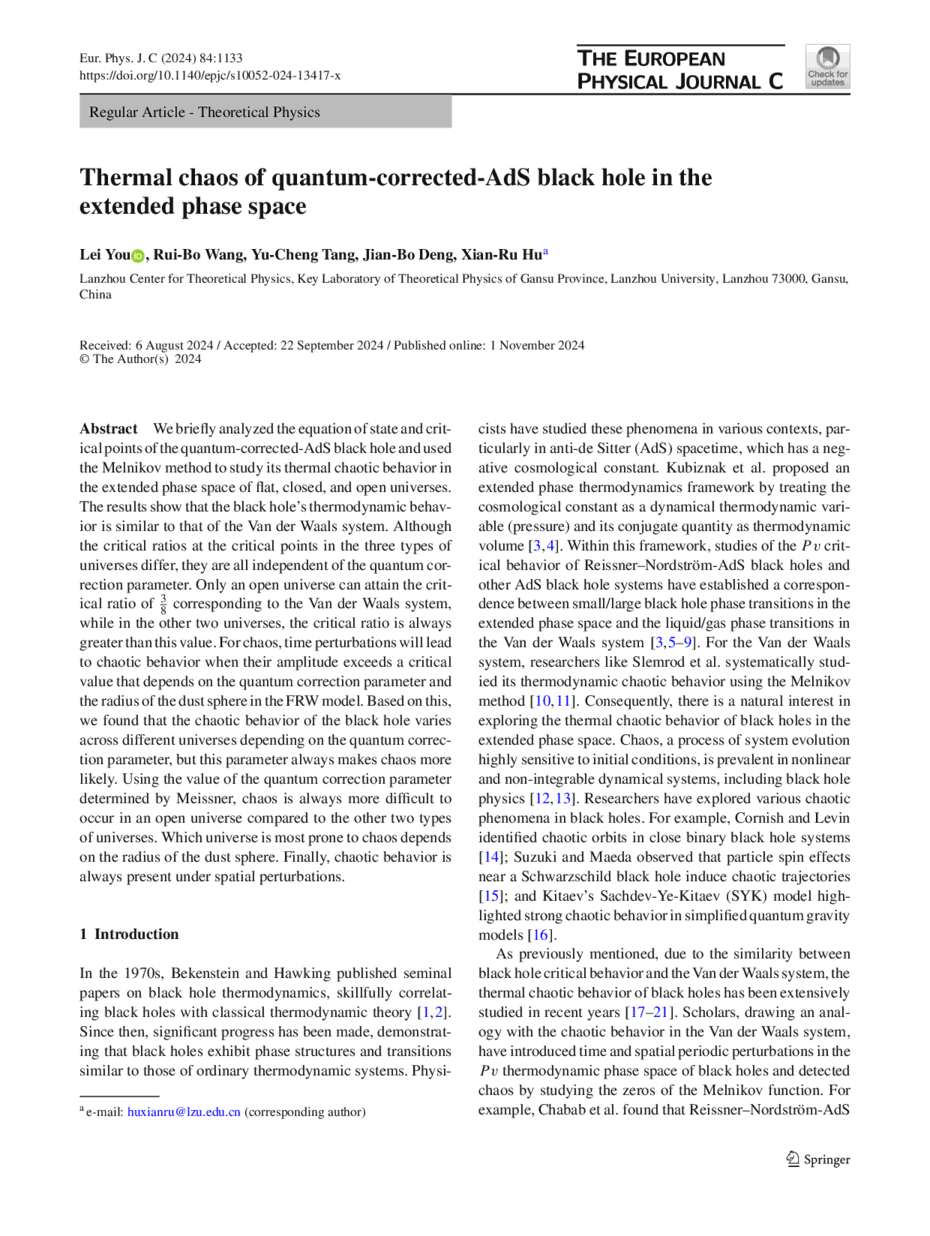https://doi.org/10.1140/epjc/s10052-024-13417-x
Regular Article - Theoretical Physics
Thermal chaos of quantum-corrected-AdS black hole in the extended phase space
Lanzhou Center for Theoretical Physics, Key Laboratory of Theoretical Physics of Gansu Province, Lanzhou University, 73000, Lanzhou, Gansu, China
Received:
6
August
2024
Accepted:
22
September
2024
Published online:
1
November
2024
We briefly analyzed the equation of state and critical points of the quantum-corrected-AdS black hole and used the Melnikov method to study its thermal chaotic behavior in the extended phase space of flat, closed, and open universes. The results show that the black hole’s thermodynamic behavior is similar to that of the Van der Waals system. Although the critical ratios at the critical points in the three types of universes differ, they are all independent of the quantum correction parameter. Only an open universe can attain the critical ratio of  corresponding to the Van der Waals system, while in the other two universes, the critical ratio is always greater than this value. For chaos, time perturbations will lead to chaotic behavior when their amplitude exceeds a critical value that depends on the quantum correction parameter and the radius of the dust sphere in the FRW model. Based on this, we found that the chaotic behavior of the black hole varies across different universes depending on the quantum correction parameter, but this parameter always makes chaos more likely. Using the value of the quantum correction parameter determined by Meissner, chaos is always more difficult to occur in an open universe compared to the other two types of universes. Which universe is most prone to chaos depends on the radius of the dust sphere. Finally, chaotic behavior is always present under spatial perturbations.
corresponding to the Van der Waals system, while in the other two universes, the critical ratio is always greater than this value. For chaos, time perturbations will lead to chaotic behavior when their amplitude exceeds a critical value that depends on the quantum correction parameter and the radius of the dust sphere in the FRW model. Based on this, we found that the chaotic behavior of the black hole varies across different universes depending on the quantum correction parameter, but this parameter always makes chaos more likely. Using the value of the quantum correction parameter determined by Meissner, chaos is always more difficult to occur in an open universe compared to the other two types of universes. Which universe is most prone to chaos depends on the radius of the dust sphere. Finally, chaotic behavior is always present under spatial perturbations.
© The Author(s) 2024
 Open Access This article is licensed under a Creative Commons Attribution 4.0 International License, which permits use, sharing, adaptation, distribution and reproduction in any medium or format, as long as you give appropriate credit to the original author(s) and the source, provide a link to the Creative Commons licence, and indicate if changes were made. The images or other third party material in this article are included in the article’s Creative Commons licence, unless indicated otherwise in a credit line to the material. If material is not included in the article’s Creative Commons licence and your intended use is not permitted by statutory regulation or exceeds the permitted use, you will need to obtain permission directly from the copyright holder. To view a copy of this licence, visit http://creativecommons.org/licenses/by/4.0/.
Open Access This article is licensed under a Creative Commons Attribution 4.0 International License, which permits use, sharing, adaptation, distribution and reproduction in any medium or format, as long as you give appropriate credit to the original author(s) and the source, provide a link to the Creative Commons licence, and indicate if changes were made. The images or other third party material in this article are included in the article’s Creative Commons licence, unless indicated otherwise in a credit line to the material. If material is not included in the article’s Creative Commons licence and your intended use is not permitted by statutory regulation or exceeds the permitted use, you will need to obtain permission directly from the copyright holder. To view a copy of this licence, visit http://creativecommons.org/licenses/by/4.0/.
Funded by SCOAP3.





